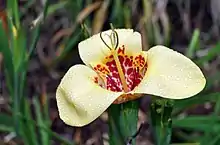Tigridia pavonia
Tigridia pavonia is the best-known species from the genus Tigridia, in the family Iridaceae. Common names include jockey's cap lily,[3] Mexican shellflower[4] peacock flower,[4] tiger iris,[5] and tiger flower.[4] The species is widespread across much of Mexico as well as Guatemala, El Salvador, and Honduras. The species is also considered naturalized in Ecuador and Peru.[4][6]
| Tigridia pavonia | |
|---|---|
 | |
| A yellow-flowered form | |
| Scientific classification | |
| Kingdom: | Plantae |
| Clade: | Tracheophytes |
| Clade: | Angiosperms |
| Clade: | Monocots |
| Order: | Asparagales |
| Family: | Iridaceae |
| Genus: | Tigridia |
| Species: | T. pavonia |
| Binomial name | |
| Tigridia pavonia | |
| Synonyms[2] | |
|
List
| |
It is very popular as an ornamental plant among lovers of interesting flowers. The blooms come in a variety of colours. They open early in the morning and are already closed around 5 P.M. when dusk begins to fall. Every day a different bloom is opened. The plants that are grown from seeds bloom in the first year after they are sowed.
The roasted bulbs are edible and have been used by the American Indians and Indigenous peoples of Mexico. It has a chestnut-like flavour.[5]
Aphis newtoni can be found on Iris bloudowii, Iris latifolia, Iris spuria and Tigridia pavonia.[7]
References
| Wikimedia Commons has media related to Tigridia pavonia. |
- "The International Plant Names Index, entry for publication Les Liliacées". which states that the author of the plant names is Redouté and not de Candolle
- "The Plant List: A Working List of All Plant Species". Retrieved 16 January 2014.
- Books, M.; Limited, M.B.P. (2004). Growing Bulbs. Murdoch Books. ISBN 9781740455206.
- "Tigridia pavonia". Germplasm Resources Information Network (GRIN). Agricultural Research Service (ARS), United States Department of Agriculture (USDA). Retrieved 16 January 2014.
- Alan Davidson The Oxford Companion to Food, p. 116, at Google Books
- Kew World Checklist of Selected Plant Families
- Proceedings of the Estonian Academy of Sciences, Biology and Ecology June 2002 Proceedings of the Estonian Academy of Sciences, Biology and Ecology June 2002, p. 128, at Google Books


